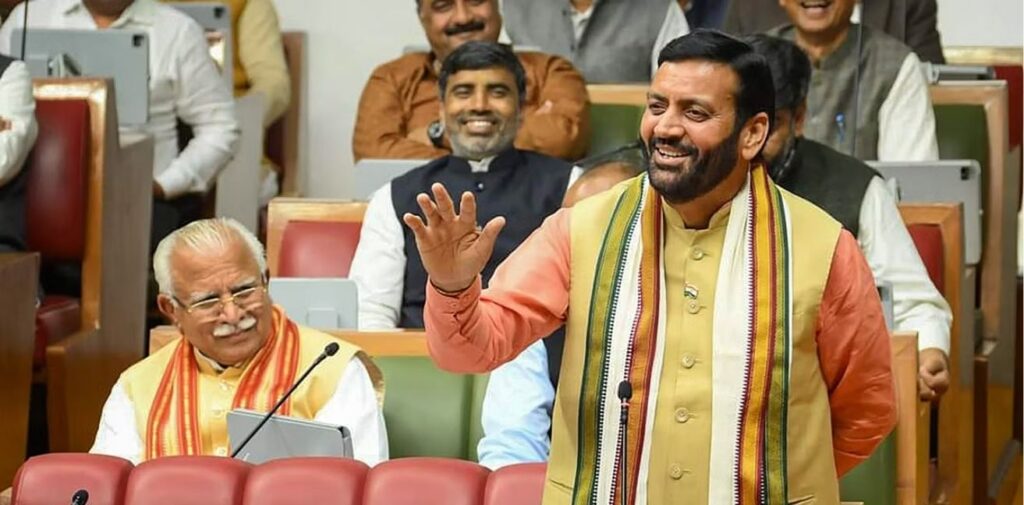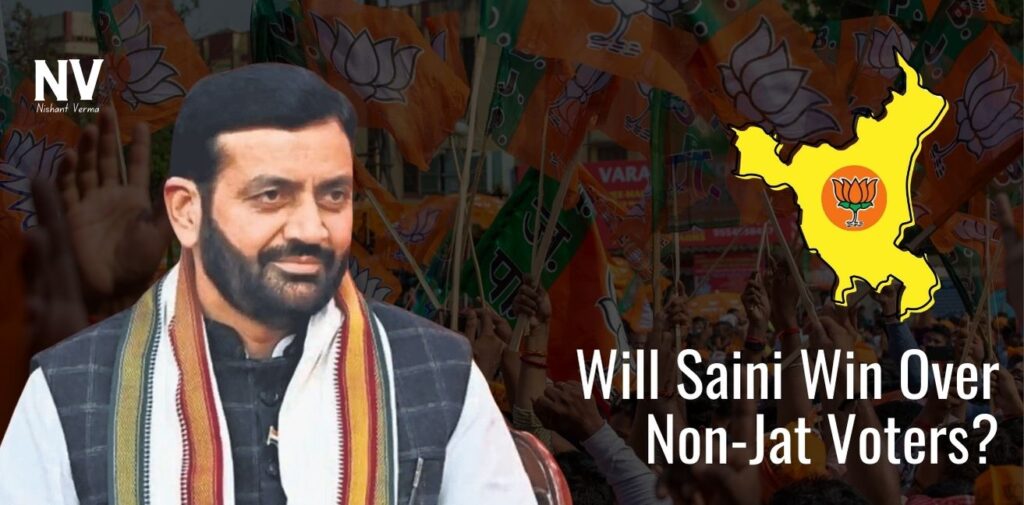In the rapidly shifting political landscape of Haryana, the Bharatiya Janata Party (BJP) has made a strategic move that has captured the attention of political analysts and voters alike. By appointing Nayab Singh Saini as the new Chief Minister of Haryana, the BJP seems to be playing a calculated game ahead of the upcoming elections. With anti-incumbency sentiments simmering across the state, Saini’s elevation is seen as more than just a leadership change – it reflects the BJP’s attempt to recalibrate its electoral strategy. But why has the BJP chosen Saini, a former computer operator, and what does this appointment signify for the party and the state’s political future?
The Unlikely Rise of Nayab Singh Saini: From Computer Operator to Chief Minister
He rise to the top position in Haryana’s political hierarchy is nothing short of remarkable. Born in a modest family, Saini’s journey from being a computer operator to Chief Minister is a story of perseverance and dedication. His political career began in local governance, and over time, his hard work and grassroots appeal earned him the recognition of the BJP leadership.
Saini’s early life saw him work as a computer operator, a humble beginning that resonated with the common man. Despite his limited background, he swiftly rose through the ranks of Haryana politics, initially gaining prominence in local municipal roles before moving into state-level politics. This meteoric rise was fueled by his connection with the people, especially non-dominant caste groups who felt underrepresented in the state’s political structure. His simplicity and relatability made him a figure many could identify with, contrasting sharply with traditional political elites in Haryana.
This backstory is essential to understanding why the BJP has placed their trust in Saini. The party, facing significant anti-incumbency due to economic struggles, rural distress, and dissatisfaction with the previous administration led by Manohar Lal Khattar, saw in Saini a fresh face who could reinvigorate the party’s appeal to Haryana’s diverse voter base.

Navigating Anti-Incumbency: Saini as a Catalyst for Change
The challenge of anti-incumbency is a significant concern for the BJP as it heads into elections. After two terms of Manohar Lal Khattar’s leadership, the party faces growing dissatisfaction from various segments of the population. Farmers, in particular, have expressed discontent over issues like agricultural reforms and economic policies. Furthermore, the state’s development has been uneven, with urban centers benefiting more than rural areas, leading to a sense of alienation among large portions of the electorate.
In this context, his appointment can be seen as an attempt to offset the growing anti-incumbency. His image as a non-traditional politician – someone who hasn’t been tainted by years of high-level governance and is unassociated with policy failures – could provide the BJP with a much-needed reset in the eyes of the voters. The party is banking on his ability to connect with the electorate on a personal level, presenting him as an outsider who understands their struggles.
Moreover, His ability to appeal to a broader demographic, especially the non-Jat voters, is crucial. Haryana’s politics have historically been dominated by Jat leaders, which has often led to feelings of exclusion among other communities. The BJP’s decision to elevate a non-Jat leader like he is a clear attempt to broaden their base and challenge the traditional caste equations that have defined the state’s politics for decades.
Appealing to Non-Jat Voters: A Deliberate Strategy
One of the primary reasons for Saini’s appointment as Chief Minister is the BJP’s focus on attracting non-Jat voters. In Haryana, caste politics have always played a significant role in electoral outcomes. The Jat community, which constitutes a substantial part of the state’s population, has traditionally been a dominant force in both politics and governance. However, in recent years, the BJP has sought to expand its influence among non-Jat communities, which include Sainis, Punjabis, Brahmins, and other smaller castes.
By choosing a non-Jat leader like Nayab Singh Saini, the BJP aims to consolidate its hold on these communities. As, a member of the Saini caste, represents a significant portion of the non-Jat electorate, and his elevation is expected to help the party counterbalance the influence of Jat leaders and political parties that traditionally draw their support from the Jat community.
This strategy of appealing to non-Jat voters also aligns with the BJP’s broader national approach of building a coalition of smaller and historically marginalized castes. Saini’s rise is a signal that the BJP is serious about challenging the traditional Jat hegemony in Haryana and offering political representation to other communities that have often been sidelined.

Addressing the Core Voter Base: Saini’s Role in BJP’s Election Strategy
Saini’s appointment is also a tactical move by the BJP to consolidate its core voter base ahead of the elections. The party’s decision to replace Manohar Lal Khattar with Saini reflects a recognition that it needed to realign its leadership with the changing political dynamics of the state. Khattar, while popular among urban voters and certain segments of the population, was increasingly seen as disconnected from the rural heartland and non-Jat communities.
Saini, with his humble background and grassroots appeal, is better positioned to address the concerns of the BJP’s core voter base, which includes a mix of urban middle-class voters, rural non-Jat communities, and other marginalized groups. His ability to bridge the gap between urban and rural constituencies is crucial for the BJP as it seeks to retain power in Haryana.
Moreover, he focus on development and governance is expected to resonate with voters who are looking for a leader who can deliver on promises of economic growth and social justice. His track record of working closely with the people, particularly in areas related to education, healthcare, and infrastructure, positions him as a leader who can address the state’s pressing issues.

The Road Ahead: Can Nayab Singh Saini Deliver for the BJP?
The appointment of Nayab Singh Saini as Haryana’s Chief Minister marks a significant shift in the BJP’s approach to the state’s politics. The party is betting on his ability to rejuvenate its image and appeal to a broader cross-section of voters, particularly those who feel marginalized by traditional caste politics. However, the road ahead is fraught with challenges.
Saini will need to navigate the complexities of Haryana’s caste dynamics while also addressing the pressing issues of governance and development. Anti-incumbency remains a potent force, and Saini will have to work hard to convince voters that he represents a break from the past and a new direction for the state.
The BJP’s decision to replace Khattar with Saini underscores the party’s recognition that it cannot afford to be complacent in the face of rising discontent. His leadership will be put to the test in the upcoming elections, and his ability to unite the party and mobilize voters will determine whether the BJP can overcome the challenges it faces.
In conclusion, Nayab Singh Saini’s rise to the Chief Ministership of Haryana is a calculated gamble by the BJP. It reflects the party’s attempt to counter anti-incumbency, appeal to non-Jat voters, and realign its leadership with the changing political landscape of the state. Whether this strategy will pay off remains to be seen, but one thing is certain: Saini’s appointment has injected fresh energy into the BJP’s campaign, and all eyes will be on him as he leads the party into the next electoral battle.




